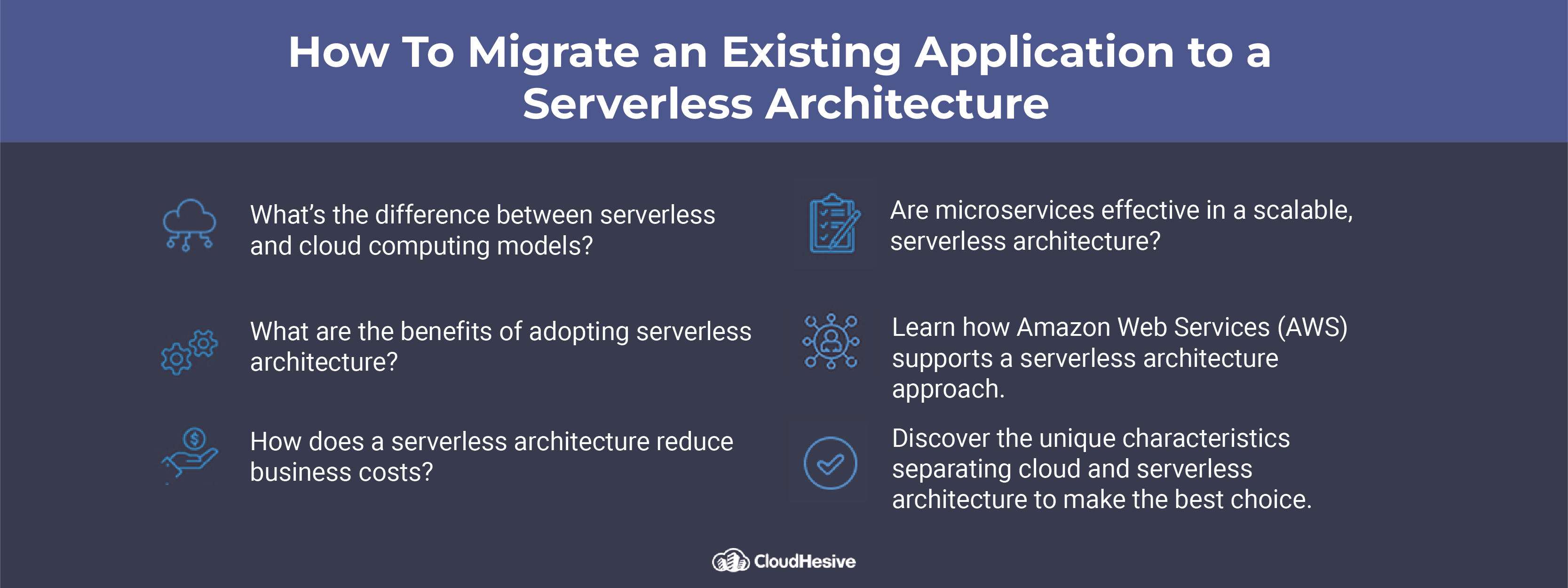Migrating existing applications to a serverless architecture
Considering moving to a serverless technology to run and host business processes? Two ways to get started are creating a new business process based on a serverless architecture or migrating an existing system to a serverless approach. Which path is best? It depends on how much goes into managing the migration without interrupting existing application functionality.
Serverless architecture provides multiple benefits, including reduced operating costs and always-on servers that support web applications on demand. Basically, servers are created on the fly only when required by the application. Instant availability creates additional scalability and improves application performance when compared to a standard cloud computing system.
Are the savings worth the migration? Migrating existing applications takes planning and strategy to not interrupt a live application. The switch to a managed service within a serverless architecture requires extensive planning and a step-by-step approach – whether you’re migrating or starting fresh.

This guide provides information on the nature of serverless architecture including benefits to the application, the business, and the development team.
Difference between cloud and serverless computing models
Serverless architecture is a cloud-native development model where developers can build and run applications without having to manage development or other servers. The serverless architecture still uses servers, but they are fully managed by the service provider. Most cloud service providers are also serverless architecture providers. For example, AWS offers both options within their infrastructure as well as combined models based on a customer’s needs.
The work involved in managing the provisioning, maintaining, and scaling the server are fully managed by the service provider. Developers simply focus on code design and deployment. No developer time is lost managing servers or releasing deployments. Instead, developers use containers or APIs that interact with the serverless system to build and deploy code.
When applications are running, the serverless provider manages scalability. In the serverless architecture, all server management including scaling is done automatically. This differs from a cloud computing system where the business manually updates their scalability based on usage data.
Cloud providers like AWS in a serverless system manage the operating system, files, security, load balancing, capacity management, scaling, logging, and monitoring. The system grants the application resources as needed and the business pays based on usage. Most serverless architectures are either backend-as-a-service (BaaS) or function-as-a-service (FaaS).
BaaS gives developers more access to third-party services and apps that offer authentication, encryption, or high-fidelity usage data. When using BaaS, the serverless functions are called using APIs.
The FaaS model sees heavier usage and is managed using development containers that are provided by the service provider. Developers can simply code and deploy to their containers, and the service provider deploys the code to the application system.
What are the benefits of serverless architecture?
Building applications on a serverless architecture offer several advantages. First, business costs are significantly reduced by not having to purchase and manage servers. Instead, the system is managed by a service provider like AWS. Although processing may take place within the AWS cloud infrastructure, it only takes place when needed.
In other words, the business is not spending money on server time until it’s used. Similar to other managed services, AWS offers multiple serverless options that are scalable up and down based on demand, so you pay only for what you use. Many AWS products offering serverless architecture may already be part of your application deployment pipeline.
Additionally, serverless architecture saves time for developers and improves the overall performance of the application for customers. Developers can leverage AWS and code using a variety of languages as needed. Microservices are also available to ease the early stage migration process. Microservices are simple to implement and replace server calls with microservice functions.
Microservices are used to reduce the amount of coupling between application flow paths. Essentially, developers use a microservice to replace individual server calls within the code. RESTful APIs are frequently used as a method to efficiently process functions within the application as needed. Microservices are not typically part of a serverless architecture, but instead used to support an ongoing migration of an existing application over to a serverless system without disrupting application functionality.
A serverless architecture provides more options for controlling application behavior. For example, developers may use triggers rather than coding separately functioning APIs.
Other benefits of adopting serverless architecture include:
- Improved scalability
- Coding flexibility
- Faster deployments and updates
- No need to purchase or manage backend servers and systems
How does serverless architecture reduce business costs?
Serverless architecture reduces business costs by providing:
- Direct, on-demand scalability so a business pays only for what is used
- No need to purchase or manage servers
- Pay as you go applies to development server space used
- Improved performance for managing and deploying code
Essentially, using a managed service like serverless architecture enables developers to focus on coding while the service focuses on managing the server system. Developers’ coding performance time improves with the increased or on-demand server space. Costs of purchasing servers and then hiring IT staff to manage them saves the business money in the short and long term.
Cloud vs. serverless – criteria for making the right choice
Migrating an existing application to a serverless architecture makes sense when the application is lightweight and doesn’t require resources 24/7. Lightweight applications tend to have shorter go-to-market times and experience alternating traffic over time. Such applications benefit from high availability and a pay-for-use model used by serverless architecture services.
Applications that require constant access and have consistently high traffic may benefit more from a standard cloud computing managed service. A cloud system may be preferred as well when a business desires to control the deployment process internally.
Need help migrating to an AWS serverless architecture? Have questions on what you need, or how to proceed? CloudHesive provides support and deep expertise in using the AWS cloud and serverless architecture for the best business advantage. As an Amazon Managed Services partner and Amazon Premier Partner, CloudHesive helps businesses take full advantage of all AWS features including serverless architecture implementation and management. See what other CloudHesive customers have to say in our many available case studies.



